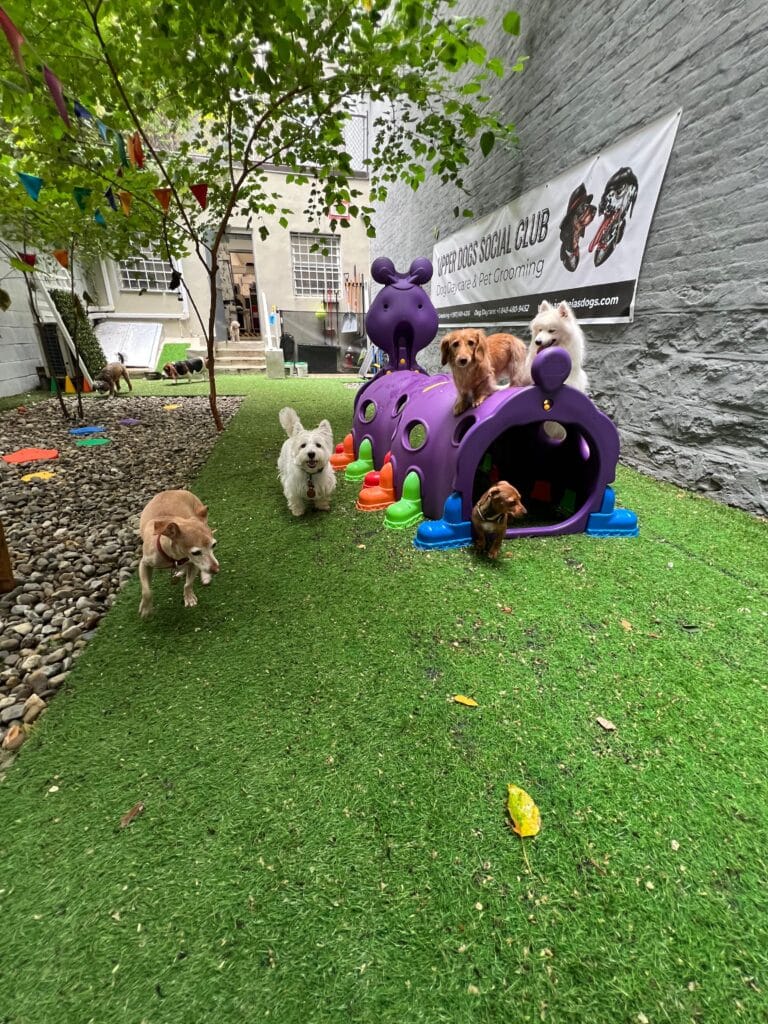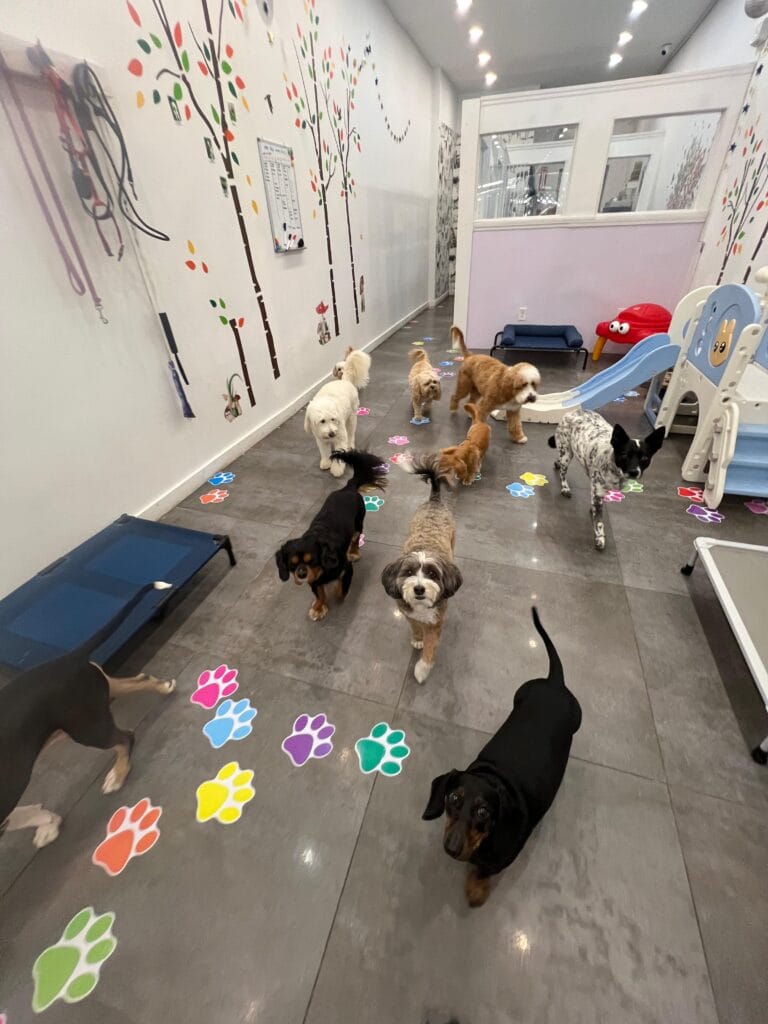Busy Manhattan dog owners often wonder how frequently their furry friends should attend daycare to stay happy and healthy in the city. This guide is for NYC pet parents juggling demanding schedules while wanting the best for their dogs.
Finding the right daycare frequency depends on your dog’s personality, energy level, and your lifestyle. Some pups thrive with daily socialization, while others prefer a few days per week — especially when attending trusted facilities like Dog Daycare in East Harlem Manhattan NYC, where personalized care and structured play make all the difference.
We’ll explore the key factors that shape your dog’s ideal daycare schedule and highlight the specific benefits regular attendance offers in Manhattan’s unique urban environment. You’ll also learn how to spot signs that it’s time to adjust your current routine and get practical tips for creating a daycare schedule that works for both you and your dog in the city.
Factors That Determine Your Dog’s Ideal Daycare Schedule
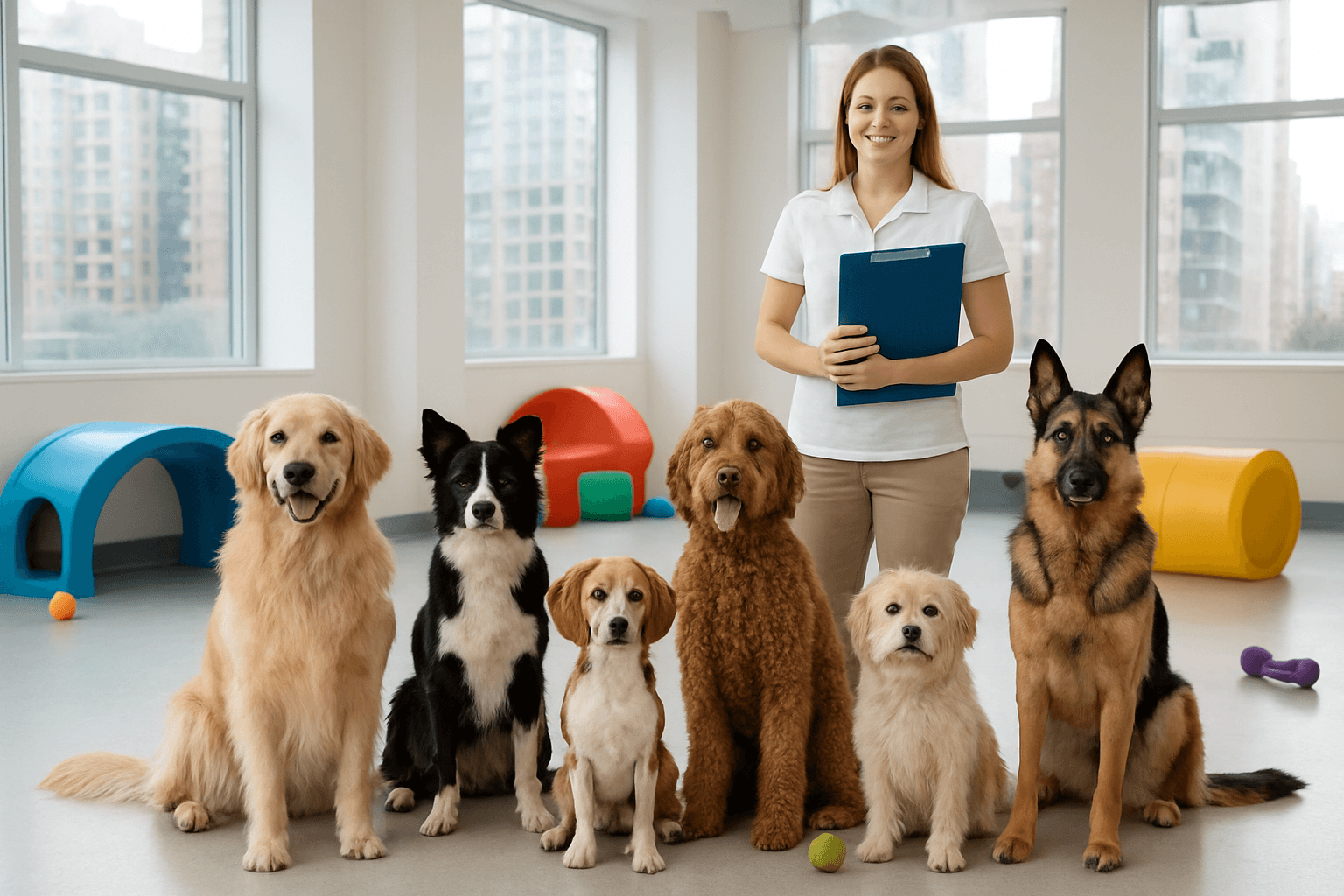
Your Dog’s Age and Energy Level Requirements
Age plays a huge role in determining how often your dog should hit the daycare scene in Manhattan. Puppies between 4-12 months are social butterflies who crave constant interaction and stimulation. These little energy bombs typically thrive with 3-5 daycare sessions per week, giving them the socialization boost they need during their critical development window.
Young adult dogs (1-3 years) often have sky-high energy levels and benefit from regular daycare attendance. Most dogs in this age group do well with 2-4 visits weekly, depending on their individual personality and exercise needs at home.
Senior dogs (7+ years) present a different picture entirely. While they still enjoy social interaction, their stamina isn’t what it used to be. One to two daycare visits per week often hits the sweet spot, providing mental stimulation without overwhelming their aging joints.
Energy levels don’t always match age expectations though. Some 8-year-old Labs still act like puppies, while certain 2-year-old Bulldogs prefer lounging to playing. Watch your dog’s behavior after daycare sessions – if they’re bouncing off the walls the next day, they might need more frequent visits. If they’re exhausted for days, consider scaling back.
Manhattan’s fast-paced environment can actually intensify your dog’s need for structured socialization, making daycare an essential outlet for burning off excess energy that apartment living might not fully address. As explained in Boosting Social Skills: How Dog Daycare Benefits Your NYC Pup, consistent daycare attendance helps dogs build confidence, improve behavior, and develop the social skills needed to thrive in the city’s stimulating environment.
Breed-Specific Socialization and Exercise Needs
Different breeds bring wildly different requirements to the daycare equation. Working breeds like Border Collies, Australian Shepherds, and Siberian Huskies were bred for jobs that demanded intense mental and physical engagement. According to the American Kennel Club (AKC), these dogs thrive when given plenty of structured exercise and mental stimulation—making daycare a true game-changer in Manhattan’s concrete jungle. These breeds typically benefit from 3-5 daycare visits weekly to prevent destructive behaviors at home.
Herding breeds such as German Shepherds and Belgian Malinois need consistent socialization to prevent overprotective tendencies. Regular daycare helps them learn appropriate social boundaries with other dogs and people.
Terriers bring their own unique challenges. Jack Russell Terriers and Bull Terriers have feisty personalities that benefit from structured play environments where they can safely express their natural boldness. Two to three daycare sessions usually work well for most terrier breeds.
On the flip side, toy breeds like Pomeranians, Yorkies, and Chihuahuas can easily become overwhelmed in high-energy daycare environments. These pups often do better with 1-2 weekly visits to smaller, calmer daycare groups specifically designed for petite dogs.
Brachycephalic breeds (flat-faced dogs) like French Bulldogs and Pugs require special attention due to breathing limitations. VCA Animal Hospitals recommends shorter, carefully monitored play sessions—especially during Manhattan’s hot summer months—to protect their respiratory health.
Your Work Schedule and Lifestyle Demands
Manhattan’s demanding work culture significantly impacts daycare decisions. Wall Street professionals pulling 12-hour days naturally lean toward full-time daycare solutions, while freelancers with flexible schedules might prefer drop-in visits as needed.
Commute times matter more than you’d think. If you’re traveling from Brooklyn or Queens into Manhattan for work, factor in those extra hours when calculating your dog’s alone time. A dog left solo for 10+ hours daily often needs 4–5 daycare days weekly to maintain emotional balance, and exploring Dog Daycare Solutions for Busy NYC Professionals: A Lifesaver can help you understand how these services support both your lifestyle and your dog’s well-being.
Unpredictable schedules common in NYC’s creative industries call for daycare facilities offering flexible booking options. Last-minute client meetings or extended shoots become manageable when you can adjust your dog’s daycare attendance on short notice.
Weekend workers face unique challenges. Restaurant staff, retail employees, and healthcare professionals often work when traditional daycare centers are closed. Look for facilities offering weekend hours to maintain consistency in your dog’s routine.
Consider your social life too. Manhattan’s vibrant nightlife and dining scene often means longer days away from home. Dogs attending daycare during busy social periods tend to handle schedule changes better than those left home alone repeatedly.
Budget constraints in expensive NYC require strategic planning. Many owners find alternating daycare days with dog walker visits creates an affordable middle ground while still meeting their dog’s social needs.
Benefits of Regular Dog Daycare Attendance in Manhattan
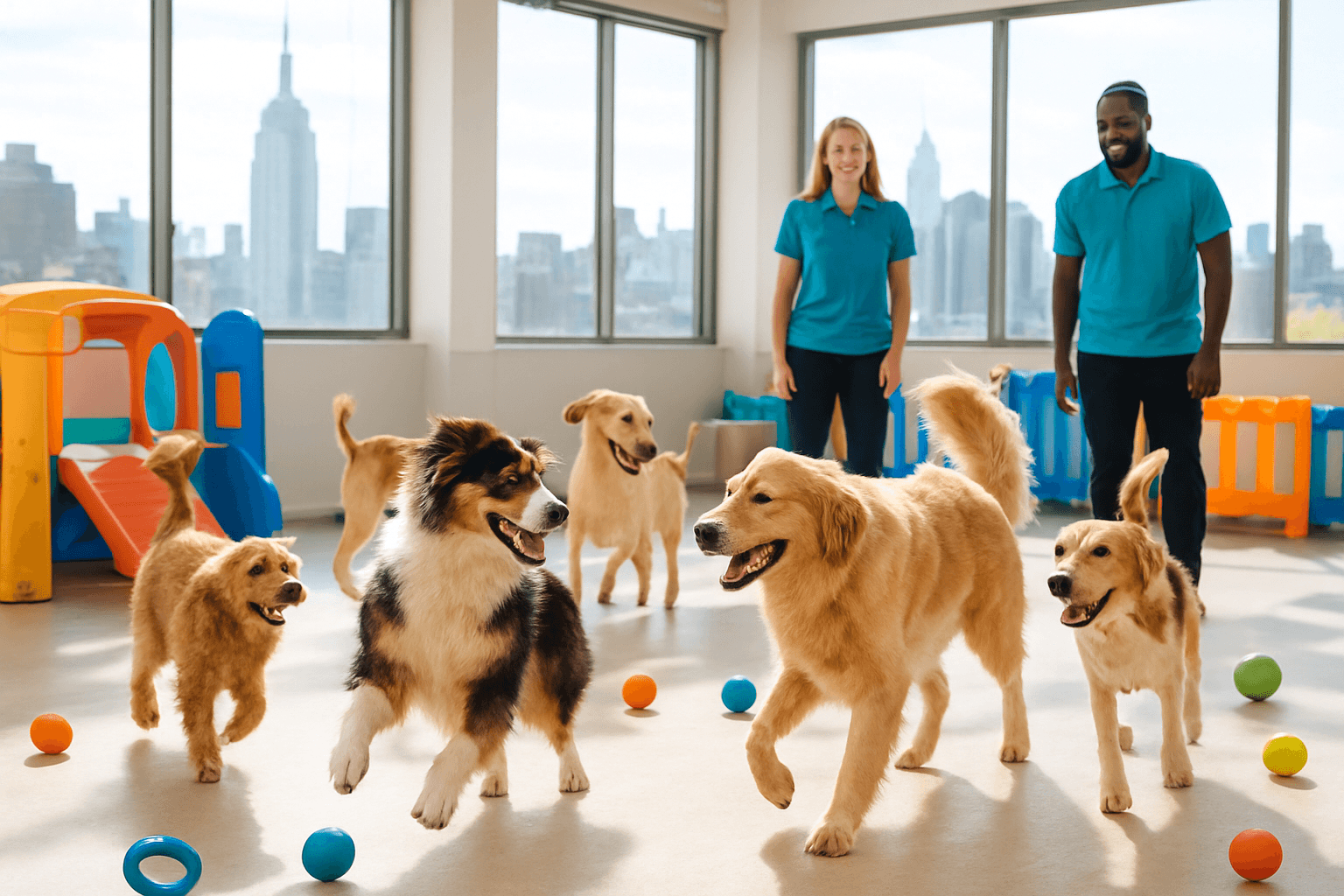
Enhanced Socialization with Other Dogs and People
Living in Manhattan means your dog encounters countless strangers, other pets, and bustling city sounds daily. Regular daycare attendance transforms these potentially overwhelming experiences into positive interactions. Dogs who attend daycare consistently develop better social cues, learning when to approach other dogs for play and when to give space. They become comfortable around different breeds, sizes, and energy levels—skills that prove invaluable during walks through Central Park or trips to the local dog run.
Professional daycare staff guide these interactions, ensuring positive experiences that build confidence rather than fear. Dogs learn proper greeting behaviors with both canines and humans, reducing the likelihood of reactive responses to strangers on busy sidewalks. The controlled environment allows shy dogs to gradually build social confidence while helping overly enthusiastic dogs learn appropriate boundaries.
Physical Exercise and Mental Stimulation Opportunities
Manhattan apartments rarely offer the space dogs need for adequate physical activity. Quality daycare facilities provide structured exercise programs that go far beyond a simple walk around the block. Supervised group play sessions allow dogs to run, chase, and engage in natural behaviors that release pent-up energy accumulated from apartment living.
Many NYC daycares feature indoor obstacle courses, puzzle games, and rotation activities that challenge dogs mentally while keeping them physically active. As highlighted in What to Expect from a Premier Dog Daycare in Manhattan, top-tier facilities go beyond simple playtime — offering structured activities and personalized care that ensure every pup stays engaged and happy. This combination prevents the restlessness and behavioral issues that often develop in under-stimulated city dogs.
Reduced Separation Anxiety and Destructive Behaviors
Manhattan’s demanding work schedules often leave dogs alone for extended periods, leading to anxiety-driven destructive behaviors. Regular daycare attendance breaks this cycle by providing structure and companionship during typical work hours. Dogs develop positive associations with being away from home, reducing the panic that triggers chewing, excessive barking, or attempts to escape.
The social interaction and physical exhaustion from daycare activities create naturally tired, satisfied dogs who rest peacefully rather than pace anxiously. This routine helps dogs understand that separation is temporary and manageable, building independence and emotional resilience that benefits both pet and owner in the long run.
Recognizing When to Adjust Your Dog’s Daycare Schedule

Signs Your Dog Needs More Daycare Time
When your dog starts showing specific behavioral changes, they’re often trying to tell you they need more social interaction and mental stimulation. The ASPCA notes that behaviors like excessive barking or restlessness may signal separation anxiety or lack of engagement. Your pup might also display restless pacing, inability to settle down, or constantly following you around the house as if they’re bored or anxious.
Destructive behaviors are major red flags that your dog needs more engagement. Chewing furniture, shoes, or household items they normally leave alone suggests pent-up energy and frustration. You might notice them digging in your yard more frequently or scratching at doors and walls. Some dogs will even start having accidents indoors despite being house-trained, which can indicate stress from insufficient stimulation.
Another clear indicator is obsessive behaviors like excessive licking, tail chasing, or repetitive movements. These often develop when dogs don’t have enough outlets for their natural instincts. If your dog seems overly excited about simple activities like walks or visitors, or shows signs of separation anxiety when you leave, they’re probably craving more social interaction with other dogs.
Pay attention to their sleep patterns too. Paradoxically, under-stimulated dogs often have trouble settling down for proper rest, leading to restless nights and tired mornings.
Warning Signs of Daycare Overuse
Too much daycare can actually harm your dog’s wellbeing, creating a different set of problems that require immediate attention. Excessive fatigue is the most obvious sign – if your dog comes home completely drained and needs days to recover their normal energy levels, they’re likely overdoing it.
Watch for personality changes that suggest burnout. Normally social dogs might become irritable, snappy, or withdrawn around other dogs or people. Some dogs develop resource guarding behaviors they never displayed before, or show increased aggression during play. These changes often indicate your dog is overwhelmed and stressed rather than happily tired.
Physical symptoms can include loss of appetite, excessive panting even when resting, or reluctance to engage in activities they usually enjoy. You might notice your dog hiding in quiet spaces more often or showing less enthusiasm about going to daycare – a significant change if they previously got excited about it.
Sleep disruptions are another warning sign. Overstimulated dogs might sleep fitfully, wake frequently during the night, or seem unable to fully relax even at home. Some dogs become hypervigilant, constantly alert to sounds and movements around them.
Mental burnout manifests as difficulty following commands they normally obey easily, seeming “spacey” or unfocused, or taking longer to settle into routines. Recovery time is crucial – dogs need downtime to process experiences and recharge mentally.
Optimal Daycare Frequency Recommendations by Dog Type
High-energy breeds like Border Collies, Australian Shepherds, and Jack Russell Terriers typically thrive with 3-5 daycare sessions per week. These dogs were bred for intense physical and mental work, so they handle frequent social interaction and exercise well. However, even these energetic pups benefit from 1-2 rest days weekly to prevent overstimulation.
Moderate-energy dogs such as Golden Retrievers, Labradors, and most mixed breeds do best with 2-3 daycare visits per week. This schedule provides adequate socialization and exercise while allowing time for home relaxation and bonding with family. Many working professionals find this frequency perfect for maintaining their dog’s happiness without overwhelming them.
Senior dogs require special consideration, with 1-2 daycare sessions weekly often being ideal. Older dogs tire more easily and need longer recovery periods between active days. Watch for signs of joint stiffness or excessive fatigue after daycare sessions, and don’t hesitate to reduce frequency as your dog ages.
Puppies need gradual introduction to daycare life. Start with just 2-3 hours once or twice weekly, slowly increasing duration and frequency as they mature and build stamina. If you’re unsure how to begin, Preparing Your Dog for Their First Day at Manhattan Daycare offers step-by-step guidance to help your pup adjust smoothly, making their first experiences positive and stress-free.
Consider your specific dog’s personality alongside breed tendencies. Shy or anxious dogs might need fewer sessions initially, while confident, social dogs often want more interaction regardless of their breed’s typical energy level.
Creating the Perfect Daycare Schedule for Manhattan Living
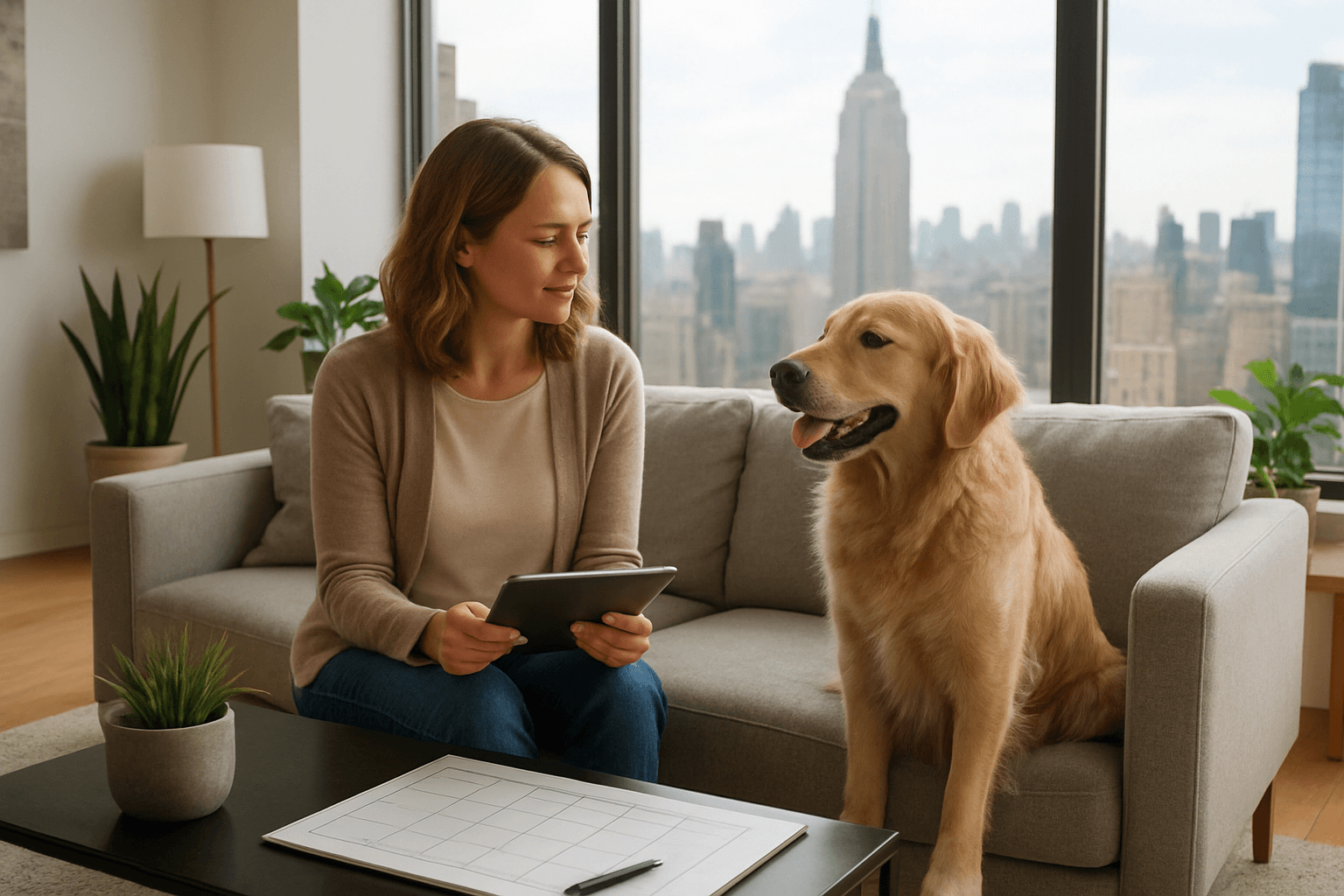
Balancing Daycare with At-Home Bonding Time
Your dog needs a healthy mix of social excitement and quiet connection with you. After a busy day at daycare, your pup will often crave downtime and one-on-one attention. Think of it like this: daycare provides the social stimulation and physical exercise, while home time builds your unique bond.
Create a routine that includes dedicated activities just for you and your dog. Morning walks before work become precious bonding moments, even if they’re just around the block. Weekend training sessions help reinforce good behavior while strengthening your communication. Evening relaxation time – whether that’s gentle brushing, calm petting, or simply having your dog nearby while you watch TV – gives them the emotional security they need.
Manhattan living means space is limited, but quality time doesn’t require a big yard. Focus on engagement rather than area. Puzzle toys, hide-and-seek games in your apartment, or teaching new tricks all build connection. Your dog should see you as their primary person, not just the one who drops them off at daycare.
Pay attention to your dog’s energy levels. Some dogs come home from daycare ready for more interaction, while others need to decompress. Adjust your evening activities accordingly – active dogs might enjoy indoor games, while tired pups prefer quiet cuddle time.
Adjusting Frequency Based on Seasons and Lifestyle Changes
Manhattan’s seasons dramatically affect your dog’s daycare needs. Winter brings shorter days and harsh weather, making daycare more valuable for exercise and vitamin D exposure. Snow and ice limit outdoor activities, so those indoor play sessions become essential for maintaining your dog’s physical and mental health.
Summer heat creates different challenges. Early morning and late evening walks become the norm, but midday walks are often too hot for safety. As highlighted in Prioritizing Safety: Dog Daycare Protocols in Urban Environments, reputable Manhattan facilities follow strict safety measures — from climate-controlled play areas to supervised hydration breaks — ensuring your pup stays cool, comfortable, and protected even during the hottest months.
Your work schedule changes everything. Remote work periods mean your dog gets more attention at home, so you might reduce daycare frequency. Business travel or busy seasons require increased daycare visits to maintain consistency. Holiday schedules, family visits, and personal commitments all factor into the equation.
Spring and fall offer the best outdoor conditions, allowing you to supplement daycare with longer walks and park visits. Take advantage of these seasons to explore different neighborhoods and give your dog variety in their routine.
Track patterns over time. Many dogs develop seasonal preferences – some love winter’s crisp air, while others thrive in summer heat. Notice how your dog responds to different weather and adjust accordingly. A flexible approach works better than rigid scheduling.
Budget and Scheduling Considerations for Optimal Care
Daycare costs add up quickly in Manhattan, so smart budgeting keeps your dog happy without breaking your bank. Many facilities offer package deals or monthly memberships that reduce per-visit costs. Compare pricing structures – some charge by the day, others by the hour, and finding the right fit saves money long-term.
Mix paid daycare with free alternatives strategically. Weekend dog park visits provide socialization without the cost. Arrange playdates with other dog owners in your building or neighborhood. These connections often lead to informal dog-sitting exchanges that benefit everyone.
Consider half-day options if your dog doesn’t need full-day stimulation. Many facilities offer morning or afternoon sessions at reduced rates. This works especially well for older dogs or those who tire easily.
| Budget Strategy | Monthly Savings | Best For |
|---|---|---|
| Package deals | 15-25% | Regular attendees |
| Half-day sessions | 30-40% | Low-energy dogs |
| Mixed schedule | 20-30% | Flexible owners |
| Off-peak times | 10-15% | Retired owners |
Build relationships with daycare staff to learn about promotions and off-peak discounts. Many facilities offer reduced rates during slower periods or for loyal customers. Some provide punch cards for occasional users or discounts for multiple dogs from the same household.
Plan ahead for expensive months. Holiday seasons, summer vacation periods, and times when you’re particularly busy often require more daycare visits. Budget for these peaks and save during slower periods to maintain consistent care without financial stress.
Conclusion

Finding the right daycare schedule for your Manhattan pup comes down to understanding your dog’s unique personality, energy level, and your family’s lifestyle. Most dogs thrive with 2-3 daycare visits per week, giving them the social interaction and exercise they crave while still maintaining that special bond with you at home. Remember to watch for signs that your schedule might need tweaking – whether your dog seems overstimulated or, on the flip side, has excess energy to burn.
The beauty of dog daycare in Manhattan is that it can adapt to your busy city life while keeping your furry friend happy and well-socialized. Many facilities, like Andreia’s Dogs, go beyond daycare — offering a full range of personalized Pet Care Services in Manhattan NYC designed to fit every dog’s unique routine. Start slowly, pay attention to how your dog responds, and don’t be afraid to make changes as needed. The right provider will partner with you to create a schedule that fits both your needs and your pup’s happiness.
Frequently Asked Question (FAQs)
There’s no one-size-fits-all answer. Most dogs do well with 2–3 days per week, balancing socialization, exercise, and rest. High-energy breeds or dogs who spend long hours alone may benefit from 3–5 visits weekly, while seniors or toy breeds often thrive with just 1–2 sessions. Watch your dog’s behavior after daycare—tired but happy is ideal; exhaustion or restlessness means adjustments are needed.
Yes—especially for socialization during their critical development window (around 3–12 months). However, puppies need a gradual introduction. Start with short sessions (2–3 hours once or twice a week) and slowly build up as they gain confidence and stamina. Always choose a daycare with puppy-safe playgroups and supervised environments.
Daily daycare is fine for high-energy or social dogs, as long as they’re not showing signs of fatigue or overstimulation. Some Manhattan dogs attend daycare full-time due to their owners’ demanding schedules. Just make sure your pup gets rest days, healthy meals, and quiet bonding time at home to recharge.
If your dog comes home excessively tired, irritable, or withdrawn, it might be too much. Loss of appetite, reluctance to attend daycare, or new aggressive tendencies also signal mental burnout. Every dog needs downtime to process social experiences—consider scaling back to a few days per week if you notice these symptoms.
Common clues include destructive behaviors (chewing furniture, scratching doors), excessive barking, or hyperactivity when left alone. If your dog seems restless or anxious despite regular walks, it’s a good sign they need more structured social and mental stimulation—something daycare provides consistently in Manhattan’s busy environment.




